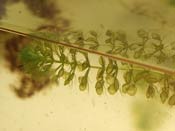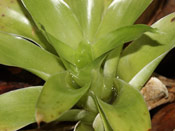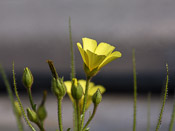Cultivation
Other Carnivorous Plants
Unfortunately, since I cannot cultivate all species and genera of carnivorous plants
(mainly because of space problems and since I could not offer optimal conditions to every plant),
here you will find a brief summary of the genera that I either do not have or that for other reasons do not have their own cultivation page.
Here are the missing genera:
Aldrovanda
English name: Waterwheel plant
Distribution: Europe, Asia, Africa and Australia
Habit, Duration: aquatic, perennial
Aldrovanda vesiculosa is the only species in this genus. The plant grows aquatically and is therefore best kept in cultivation in an aquarium.
The plant grows up to 25 cm long. The traps are similar in mechanism to Dionaea muscipula, since they are also snap traps.
This species is actually widespread, but since small stagnant waters are becoming increasingly rare, it is now almost extinct at some locations.
The white flowers are unfortunately very rarely seen.



Light: bright
Humidity: ---
Water temperature: >20 °C in summer
Substrate: Rainwater, for the ground: peat mixture
Water: pH value: approx. 6
Propagation: Division, seeds
Brocchinia (only B. hechtioides and B. reducta)
Distribution: Venezuela and Guyana
Habit, Duration: terrestrial, perennial
B. hechtioides and B. reducta are the only two species of the genus that differ from the others.
The leaf surface is so slippery that prey animals can easily fall into the leaf funnel, which is filled with water, and drown.
At first it was assumed that the plants do not have their own enzymes for digesting prey and are dependent on bacteria,
but recent studies have shown that B. reducta produces enzymes and is therefore really carnivorous.
Released nutrients are then taken up by the plant via suction scales. Since no results are available for B. hechtioides,
this species is still considered to be precarnivor.
Another specialty of B. reducta is the fact that this carnivorous plant can be the habitat for another carnivorous plant.
Every now and then one can find U. humboldtii in the leafs of this species.

Light: very bright
Humidity: >70 %
Temperature: Day: 20-25 °C, night: 10-15 °C
Substrate: Peat-sand-perlite mixture or sphagnum moss
Watering: no accumulation, keep the substrate moist and fill the leafs with water
Distribution: Seeds
Byblis
English name: Rainbow plant
Distribution: Australia, Indonesia and Papua New Guinea
Habit, Duration: terrestrial, annual or perennial
A very beautiful genus that only includes a few species. The genus occurs only in Australia.
Only B. liniflora has been discovered in Papua New Guinea and Indonesia. Some species can grow up to 60 cm high and the plants are also completely covered with adhesive droplets.
They also catch their prey with these passive traps. What is special about this genus are in my opinion their countless pink flowers.
By the way, some species of this genus are annual, e.g. Byblis liniflora. This species is also the most common in cultivation. It can also be very well propagated by seeds.



Light: very bright
Humidity: 70 %
Temperature: Summer: 20-25 °C, winter: colder
Substrate: Peat-sand mixture
Watering: Pot always in about 1 cm of water, drier in winter
Propagation: Seeds
Catopsis (only C. berteroniana)
Distribution: Florida up to Mexico, Central America, Caribbean islands to Ecuador and Brazil
Habit, Duration: epiphytic, perennial
C. berteroniana is the only precarnivorous species in the genus Catopsis. The plant is an epiphytic species from the Bromeliaceae family and, like all species of the genus, collects water in the specially shaped leaf funnels. With the help of bacteria and fungi, this species can decompose drowned or trapped insects and absorb the released nutrients. Since the species does not have its own enzymes for digesting their prey, it is therefore considered to be pre-carnivorous.

Light: very bright
Humidity: >70 %
Temperature: Day: 20-25 °C, night: 10-15 °C
Substrate: Sphagnum mixture
Watering: no accumulation of water
Propagation: Seeds, runners
Drosophyllum
English name: Portuguese sundew
Distribution: Portugal, Spain and Marocco
Habit, Duration: terrestrial, perennial
This monotypical genus includes only one species: Drosophyllum lusitanicum.
The plant only occurs in Portugal, Spain and Morocco. There it only grows on very sandy terrain.
That is why the roots of the Portuguese sundew also become very long, since it receives very little water there.
The plant is said to be very root sensitive and does not forgive any mistakes.
The adhesive drops are somewhat reminiscent of Drosera, but these are passive adhesive traps. That means they are immobile.
The leaves are up to 30 cm long. It should also be mentioned that the plant smells like honey and thus attracts its prey.



Light: very bright
Humidity: 40-60 %
Temperature: Summer: 20-30 °C, colder at night, winter: 5-15 °C
Substrate: Peat-sand-perlite mixture
Watering: no accumulation of water
Propagation: Seeds
Genlisea
English name: Corkscrew plants
Distribution: Africa, Madagascar, Central and South Amerika
Habit, Duration: terrestrial, annual or perennial
This genus currently includes over 20 species. The small rosette-forming plants grow terrestrial and also semi-aquatic.
With their "roots" converted into traps, the plants catch their prey by microscopic animals entering the traps through small openings.
Inward-looking "hairs" pass them on to a kind of digestive chamber and at the same time prevent them from escaping.
In cultivation, Genlisea likes it very wet and sometimes wants to be flooded. The water should be changed regularly, otherwise the plants may die.



Light: bright
Humidity: >80 %
Temperature: all year round 20-30 °C
Substrate: Peat-sand mixture
Watering: accumulation, old water should be replaced by fresh water
Propagation: Seeds, leaf cuttings, division
Philcoxia
Distribution: Eastern Brazil
Habit, Duration: terrestrial, annual or perennial
The genus Philcoxia includes three species (P. minensis, P. goiasensis and P. bahiensis)
that were only described a few years ago. Since the plants look similar to the species of the bladderwort family, they were at first assigned to them.
According to the latest studies, they belong to the Plantaginaceae.
The plants grow on temporarily dry sandy soils at altitudes between 800 and 1450 m. These plants catch their prey with the help of their small leaves,
which lie on the sand surface and are equipped with glands. Numerous captured nematodes were repeatedly discovered on these sticky traps.
Apparently, the cultivation of these species proves to be difficult, which is why it is said that there are still no plants in cultivation for a longer period.

Picture by C. Dietz

Picture by C. Dietz

Picture by C. Dietz
Roridula
English name: Fly bush
Distribution: South Africa
Habit, Duration: terrestrial, perennial
R. dentata and R. gorgonias are the only two species in the genus Roridula.
The plants reach heights of up to 2 m and are found in South Africa in the area of the cedar mountains and around Hermanus.
Insects are caught with the numerous glands that cover the plant. However, in contrast to real carnivores, the species do not digest their prey themselves,
but are dependent on help: bugs of the genus Pameridea inhabit the plant and suck out trapped insects.
The plant then uses the excretions of the bugs as fertilizer. Roridula is therefore considered to be precarnivor.
The plant is not a threat to the bugs themselves. Furthermore, the bugs also appear to be helpful in pollinating the flowers.



Light: bright
Humidity: 40-60 %, airy location
Temperature: Summer: 20-35 °C, colder in winter (10 °C)
Substrate: Peat-sand mixture
Watering: moderately moist all year round
Propagation: Seeds, shoot cuttings
Stylidium
English name: Trigger plant
Distribution: Australia
Habit, Duration: terrestrial, annual or perennial
The genus Stylidium comprises over 300 species and is therefore one of the most species-rich genera in Australia.
What is special about the plants are the blossoms or the pistil, which hits the pollinators like a hammer when they are touched (dusting them with pollen).
Since the plants are covered with glands and insects were found on the plants, it was finally proven in 2007 that this genus is carnivorous.
Because for me the principle of attracting the prey was not completely fulfilled, I consider the genus rather "borderline" and do not necessarily accept it as carnivore on my homepage.
Thus, the genus Utricularia remains the largest carnivorous plant genus for me.
There are only a few species in cultivation. S. debile (see cultivation information) is particularly popular because this species is quite undemanding.



Light: bright
Humidity: 60 %, relatively undemanding
Temperature: Summer: 20-30 °C, colder in winter
Substrate: Peat-sand mixture
Watering: Pot always in about 1 cm of water
Propagation: root runners
Triphyophyllum
Distribution: Western Africa
Habit, Duration: Liana, perennial
Triphyophyllum peltatum is the only species in the genus and is therefore monotypic.
The liana goes through three phases during its life time, of which only the second one is carnivorous.
In this phase, it is about 35-40 cm high and forms leafs with glands. When the plant has collected enough nutrients for the last stage,
it sprouts completely and reaches a total length of up to 7 m.
The cultivation of this species turns out to be somewhat difficult. For this reason, they are only occasionally found in botanical gardens.

Light: bright?
Humidity: >80 %
Temperature: >20 °C
Substrate: pure, well drained humus
Watering: no accumulation of water
Propagation: Seeds


